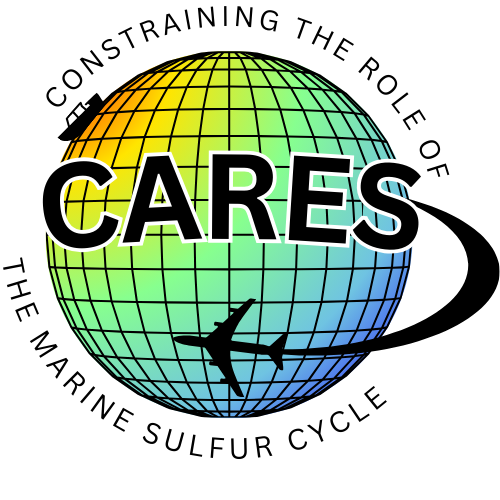
║ Project Design
Study Area
To achieve our objectives, the CARES project combines a comprehensive modelling and observational programme involving ship and aircraft measurements.
Our focus area is the North East Atlantic where springtime phytoplankton blooms are prolific (Fig. 1) and atmospheric conditions enable the examination of sulfur chemistry across a range between clean background levels (especially after precipitation) and strong anthropogenic influence (e.g. due to ship emissions and continental outflow).

The study location will build on past experiments in the region (MAP, NAMBLEX, PARFORCE, EASE, ITOP, DOGEE) as well as more recent ones (ATom, NAAMES, ACE-ENA) and our own work through the NERC ACSIS project (Fig. 2).

Left panel: May 2018; Middle panel: February 2019; Right panel: August 2019. ppt* denotes a mixing ratio based on applying formic acid sensitivity to the mass spectrum. The background maps show satellite monthly average chlorophyll concentration.
Focus
Our overall ambition is to combine observational data and models to deliver improved understanding in the marine atmospheric sulfur cycle in order to improve model processes and make accurate predictions of their climate impacts.
Our primary focus is the UK Earth System Model (UKESM), but through our Project Partners we will influence a range of international modelling centres (NCAR, NOAA). This will result in greater fidelity than is possible with the current suite of ESMs (used for the most recent IPCC report), which means that CARES results will have significant policy as well as academic implications.
Organisation
CARES is organised into two Preparatory Activities (PAs), which underpin two Enabling Activities (EAs). These activities and their tasks provide the structure for three hypothesis-driven Scientific Work Packages (SWPs)
Detailed mission planning and preparation of instruments for the joint aircraft-ship field study will take place in PA1. Analysis of a model Perturbed Parameter Ensemble (PPE) of simulations (PA2) will be used to inform PA1 with regard to key sensitivities in sulfur cycling in different environmental conditions, enabling optimisation of the field campaign to help target the most relevant observations and processes.
The outputs from the field campaign (EA1) will inform the development of an optimised model framework (EA2), and the combination of field data and optimised model configurations will be used to deliver the SWPs.
SWP-A and SWP-B will deliver new knowledge of atmosphere-ocean exchange of sulfur gases and their processing in the atmosphere respectively.
SWP-C will use the observationally-constrained optimised model configuration (EA2), incorporate new understanding from SWP-A and -B, and assess the chemistry-aerosol-cloud impacts at regional and global scales.

CARES Project Design
related pages
